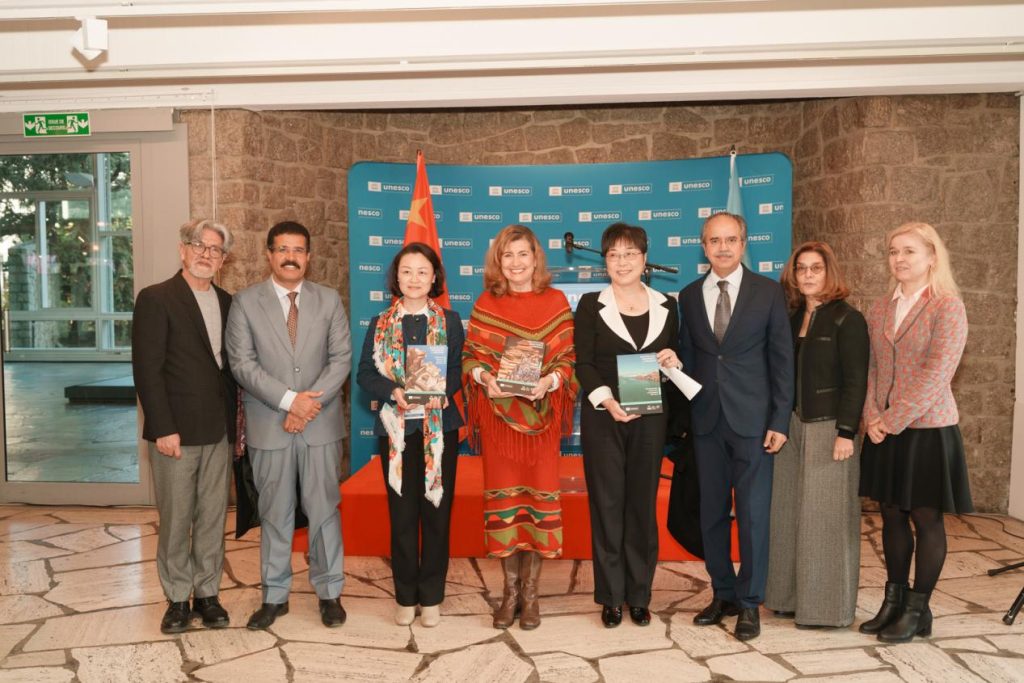2024 “Nanjing Week” at UNESCO: Deepening Civilizational Exchanges and Mutual Learning through Revival of Silk Road Heritage
NANJING, China, Dec. 6, 2024 /Xinhua-AsiaNet/–
Following the “Brocade and embroidery, a fibre which connects us” themed art exhibition held at the Louvre in Paris, the 2024 “Nanjing Week” returns to France after a month. On December 4, the exhibition “Thematic Collection of the Cultural Exchanges along the Silk Roads: Architecture, Monuments and Urbanism,” co-hosted by the Nanjing Municipal People’s Government and UNESCO, officially commenced at the UNESCO headquarters in Paris.

At the exhibition of “Thematic Collection of the Cultural Exchanges along the Silk Roads: Architecture, Monuments and Urbanism”, guests posed for photos with the newly published book.
The exhibition primarily presents key chapters from the latest publication of the UNESCO flagship project “Thematic Collection of the Cultural Exchanges along the Silk Roads”, focusing on the volume titled “Architecture, Monuments, and Urbanization”. Through the lens of architecture, monuments, urban design, and construction along the Silk Road, the exhibition uses images and text to showcase the cultural and technological exchanges between different civilizations along the route over several centuries.
“We have been collaborating with the city of Nanjing for many years.The major contribution that we are making today is that we’re putting together ‘The Silk Roads’ publication that is showing the beauty of the exchanges all along the Silk Road,” said Gabriela Ramos, Assistant Director-General for Social and Human Sciences at UNESCO, during her speech. “It reminds us that we are a single humankind, and that we can work together exactly with this mandate that UNESCO has on promoting intercultural dialogues.”
Michael Turner, the Chairholder in Urban Design and Conservation Studies at UNESCO, and the Thematic Collection coordinator and co-editor, underscored the pressing need in our era, marked by cultural integration and collaborative exchange as global trends, to reinterpret the connections between different civilizations and give new meaning to the architectural heritage and urban development along the Silk Road.
“Heritage preservation and international cooperation are indispensable parts of East-West cultural exchange,” stated Wang Xiaoyan, Director of the Information Office of Nanjing Municipal People’s Government, during the opening speech. In 2022, Nanjing collaborated with UNESCO’s “Thematic Collection of the Cultural Exchanges along the Silk Roads: Architecture, Monuments and Urbanism”. Renowned experts from around the world in the fields of architecture and monuments joined forces to trace the historical and geographical marks of architectural exchanges along the Silk Road. Currently, Nanjing is continuing to implement cultural heritage preservation projects, promoting the joint application for the inscription of the Ming and Qing city walls as a UNESCO World Heritage Site. While expanding the city’s international cultural influence, Nanjing is also enhancing awareness of heritage site protection, effectively fostering harmonious coexistence and mutual understanding between different cultures.
As an important hub city at the crossroads of the Belt and Road Initiative, Nanjing showcases its unique role in international cultural exchanges through its ancient and modern aspects in the exhibition. As the only ancient capital of China located south of the Yangtze River, Nanjing is situated near the river and the sea, with a distinctive maritime culture. It has inherited the maritime Silk Road from the Qin and Han dynasties, and its maritime connections with East Asia and Southeast Asia evolved from sporadic activities to sustained and stable relationships. Today, Nanjing works closely with UNESCO, contributing to peace and sustainable development through activities such as the World Historical and Cultural City Expo, the International Youth Forum on Creativity and Heritage along the Silk Roads, and the Yangtze Culture Forum, offering China’s solutions to global challenges.
Representatives from international organizations, experts, scholars, and think tank representatives at UNESCO’s headquarters visited the exhibition on the opening day. “The exhibition is very interesting! I had only a general understanding of the Silk Road before, but today I have learned more about it. I also hope that more people will get involved,” said a staff member from UNESCO’s headquarters.